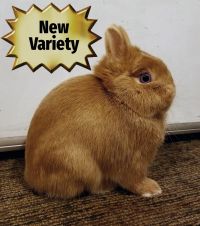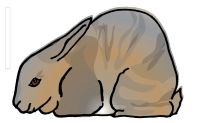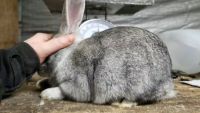Advanced Color Genetics
More Advanced Color Genetics:[edit | edit source]
BROKEN LOCI[edit | edit source]
- En-broken
The broken Pattern is dominate to solid. Rabbits with two Broken Geans are called Charlies and should be only very carefully bred. The Broken gene when homozygous (doubled up) carries a 70% probability of producing a Rabbit with megacolon, a digestive tract disorder.
Vienna[edit | edit source]
- V-Vienna
Vienna is most frequently known for Blue eye white as two copies of "v" will produce a solid white rabbit with blue eyes. Vienna is a co-dominate gene, and a "Vv" rabbit is a Vienna carrier, in this case some random white markings can bleed through including the brilliant blue eye color in one , part of or both eyes. Vienna Blue Eye White is Homozygous recessive. 2 copies "vv" are required to make a BEW
Wideband[edit | edit source]
- W-Wideband
Wide band is a trait modifier gene that will effect Agouti based rabbits. the wide band gene extends the band coverage, primarily on Chestnuts, Reds, and Chinchillas. a chestnut will have a larger area of Pheomelanin showing on the coat and less white, and more red/yellow on it's belly(Coppers), a Chinchilla will have more white on it's coat and more white on it's belly, and a red will have a more solid red belly extended from it's back. Wide band high rufus reds and chestnuts are the most sought after to improve color in a new Zealand red program.
Normal bandwidth Rabbits are dominate "W" Wideband Rabbits are Homozygous Recessive "ww"
Dutch[edit | edit source]
- Du-regular color
dud- Dutch dark duw- Dutch white
https://www.adhrc.com/Forms/Color%20Genetics%20of%20the%20Dwarf%20Hotot.pdf
Silver[edit | edit source]
- Si-Silver
Silver gene is indicated by full solid white hairs from root to tip evenly inter mixed with the body color hairs .
Lutino[edit | edit source]
"The lutino coloration is called a "p mutation" because of an integral membrane p protein. The p-protein appears to be a transporter, however for exactly what remains unknown. Because high levels of tyrosine induce pigmentation in the eye’s melanocytes it would suggest this p protein plays a role in tyrosine transport. It does not only affect the eye but coat color as well. It is recessive (so P is normal and p is the mutation) and a rabbit that is pp will have the pink eyes and also the fur color changes. In a sense, this mutation causes an effect similar to the non-extension gene, just to a less degree and with the addition of the pink eyes. This is due to the decreased production of eumelanin with yet little effect on pheomelanin. While there could be different variants, the basic orange colored lutinos are genetically A_B_C_D_eepp. Cream colored lutinos (called “Shadow”) and are genetically A_B_C_D_E_pp. The p mutation can create other colors with different base genotypes. This is not a "new" mutation. It is the one of the more common forms of albinism. The official name is type II oculocutaneous albinism. It is a Tyrosinase positive form. In mice, the protein product of this p locus’ first intraluminal loop was studied back in 1994. In mice, William Castle wrote about it in 1909. So as one can see, this has been a long studied mutation. However, we still have a lot to learn about exactly what this transport protein does and the exact mechanism by which it works." -Amy's Rabbit Ranch
1. Rosemblat, Susana. et al. Identification of a melanosomal membrane protein encoded by the pink-eyed dilution (type II oculocutaneous albinism) gene. PNAS. December 1994; 91: 12071-12075. 2. Russell, ES.Genetics 34: 146 March 1949 3. Castle, WE. The Peculiar Inheritance of Pink Eyes Among Colored Mice.Science. 3 September 1909; 30(766): 313-314.
""The Lutino gene is a gene that is more commonly found in mice, cavies and birds. The Lutino has been around for a few years, dating back to 1985 where a Danish breeder came across the color in a litter of Harlequin Netherland Dwarfs. Thay have since popped up in parts of Scandinavia into Holland, the UK and the US, starting with Bob Whitman exporting some over around 2005. Unfortunately, the color disappeared from the US until 2014 when Allen Messick and Randy Shumaker imported several Lutino Netherland Dwarfs from the UK. in an effort to develop the variety in American Netherland Dwarfs,
The Lutino gene acts as a color stripping gene, similar to the color stripping nature of the Chinchilla gene. The Chin gene removes the red, yellow and beige pigments from the hair shaft. Similarly, the Lutino gene does the same, but instead of removing the red, yellow and beige, it removes the black pigments instead. So a chestnut or castor will be stripped of the black tipping, leaving behind a rich, fiery red. A self black will turn a dove beige, etc. In addition, the black pigment of the eyes will also be stripped, leaving behind a pink eye of various hues, depending on the variety. "" https://softpawsrabbits.weebly.com/the-lutino-gene.html
Modifiers[edit | edit source]
Modifiers are not gene on their own but the extent of coverage that rabbit is presenting.
Intensity of Red[edit | edit source]
The intensity of Red is a gene modifier that controls how saturated the Pheomelanin is in a rabbits coat. We refer to this as Rufus. A rabbit with very little intensity can look almost like a dirty white, while a Rabbit with extremely high Rufus can present as a deep mahogany maroon color. Rufus can also play a role in the quality of other coat colors becuse it turns up the saturation on pigments in the hair follicle. example: a truly rich inky black rabbit has a high Rufus, while a low Rufus Rabbit will appear a duller more charcoal black.
Extent of Broken Pattern[edit | edit source]
- "Charlie "
- Broken
- Blanket
- Booted
co-dominate, cryptic and ghost presentations of colors:[edit | edit source]
Genes that are partially dominate even when recessive and Genes that present more intense when doubled up ie produce "phantom" colors , colors that present as something they aren't.
*ej- Harlequin[edit | edit source]
Harlequin *ej* can bleed through on self "aa, Eej " Chinchilla "A, chd, Eej" Chestnut " A, Eej " . "ej" paired with Steel (Es) can produce a phantom Black rabbit or super steel. Where there may only be a hint of a barred pattering in the tips of the hairs, looking closely you may see some intersperses gold or while tips or barring visible around the belly or in direct sunlight, but at a glance the rabbit may appear to be solid black.
.
*chl- Chinchilla Light/Shaded[edit | edit source]
chlchl = seal a more intense shaded pattern chdchl =
*ES- Steel[edit | edit source]
"EsEs" "Ese" & "Esej" can present as Black
ABCDEsEs
ABCDEse
ABCDEsej
Can all present as soild black .
*Ed -Dominate Black[edit | edit source]
Black can present on Agouti based rabbits due to other genes effects on coat pattern ie :ABCDEd , Ed dominate black extends the Eumelanin band on an agouti rabbit fully from root to tip, masking any pattern banding and presenting as a self black rabbit. This can be tricky to figure out. Breed your suspected Ed rabbit to a few self rabbits and if you produce a chestnut or agouti pattern one of them is a Cryptic Self, with Ed. is can also be tested with a red gene but will be a little more difficult swapping back and forth to figure out the genotype via color testing. .
https://extension.oregonstate.edu/gallery/rabbit-coat-color-genetics-gallery
https://thenaturetrail.com/rabbit-genetics/color-e-extension-series-steel-tricolor-locus/
https://www.frontiersin.org/articles/10.3389/fgene.2019.00875/full
"""Classical genetic studies carried out in rabbits have suggested that the Extension series in this species is determined by five alleles [30,31,37,38,39,40]. Allele ED determines the dominant black coat color and is caused by one in-frame deletion of 6 bp (c.280_285del6 or D6 allele), which eliminates two amino acids in the second transmembrane domain [41]. The black color of the spots of the Checkered Giant breed is due to this allele. Allele ES (steel) is considered a weaker version of ED, even if it could be probably determined by the same mutation causing ED, as another MC1R variant associated to this allele has not been described so far"""
https://www.mdpi.com/2076-3417/11/1/373/htm





